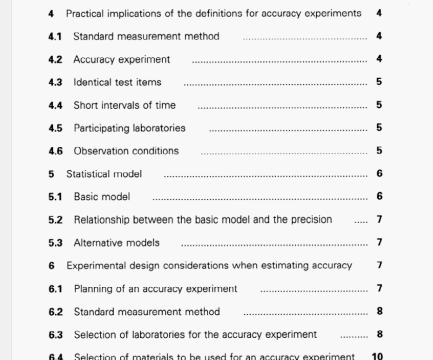ISO 5725-1 pdf download – Accuracy (trueness and precision) of measurementmethods and results — Part 1: General principles and definitions.
3.10 bias of the measurement method: The difference between the expectation of test results obtairied from all laboratories using that method and an accepted reference value.
NOTE 6 One example of this in operation would be where a method purporting to measure the sulfur content of a cxAnpound consistently fails to extract all the sulfur, giving a negative bias to the measurement method. The bias of the measurement method is measured by the displacement of the average of results from a large number of differueit laburatories all using the same method. The bias of a measurement method may be different at different levels,
3.11 laboratory component of bias: The difference between the laboratory bias and the bias of the measurement method.
NOTES
7 The laboratory component of bias is specific to a grven laboratory and the conditions of measurement within the ldboralory. arid also it may be different at different levels of the test.
8 The laboratory .u1Tiporient of bias is relative to the overall average result, not the true or reference value.
3.12 precision: The closeness of agreement between independent test results obtained under stipulated conditions.
NOTES
9 Precision depends only on the distrution of random errors and does not relate to the true value or the specified valiin
10 The measure of precision is usually expressed in terms of imprecision and computed as a standard deviation of the test results. Less precision Is reflected by a larger standard deviation.
11 ‘Independent test results’ means results obtained in d rndnr1l ilut inFluenced by any pieviuui ieult on the same or similo- test objoct. Quantitative moasurc of precision depend critically on the stipulated conditions. Repeatability and reproducibility conditions are particular sets of extreme conditions.
4.1.1 In order that the measurements are made in the same way, the measurement method shall have been standardized. All measurements shall be carried out according to that standard method. This means that there has to be a written document that lays down in full detail how the measurement shall be carried Out, preferably including a description as to how the measurement specimen should be obtained and prepared.
4.1.2 The existence of a documented measurement method implies the existence of an organization re sponsible for the establishment of the measurement method under study.
NOTE 22 The standard measurement method is discussed mole fully in 6.2.
4.2 Accuracy experiment
4.2.1 The accuracy (trueness and precision) moos urcs houId be determined from a series of test results roported by the participating laboratories, organized under a panel of experts established specifically for that purpose.
Such an interlaboratory experiment is called an “accuracy experiment”. The accuracy experiment may also be called a precision” or ‘trueness experiment’ according to its limited purpose. If the purpose is to determine trueness, then a precision experiment shall cithor havo bccn complctcd previously or shall occur simultaneously.
The estimates of accuracy derived from such an experirnent should always be quoted as being valid only for tests carried out accoiding to the standaid measurement method.
4.2.2 An accuracy experiment can often be considered to be a practical test of the adequacy of the standard measurement method. One ot the main purposes of standardization is to eliminate differences between users (laboratories) as far as possible, and the data provided by an accuracy experiment will reveal how effectively this purpose has been achieved. Pioiiounced differences in the within-laboratory vanar ces (see clause 7) or between the laboratory means may indicate that the standard measurement.
ISO 5725-1 pdf download – Accuracy (trueness and precision) of measurementmethods and results — Part 1: General principles and definitions
